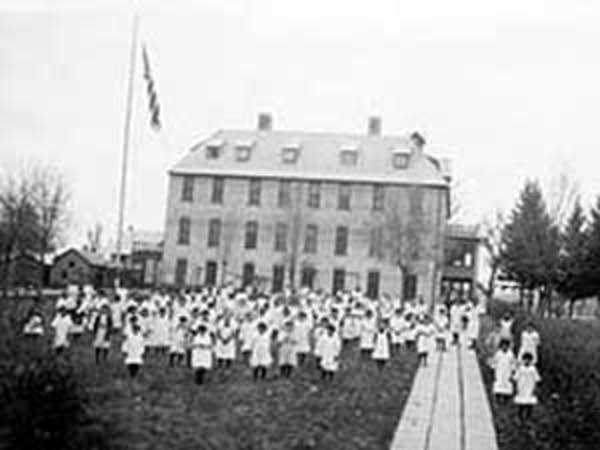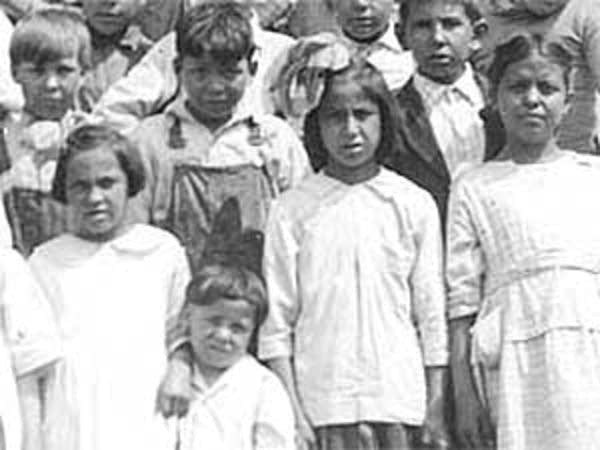The deep roots of social breakdown

Starting in the late 1800s and continuing into the mid-1900s, Indian children were required to leave home at 5 or 6, and attend government boarding schools until age 18. The boarding schools were often far from the reservation where the children lived.
BOARDING SCHOOLS STOLE CULTURAL IDENTITY

The goal was to force the assimilation of Indians into white culture. Traditional language, culture and spirituality were forbidden.
The children were often treated harshly if they spoke their language or "acted Indian." One government official wrote, "The goal is to kill the Indian, but save the man."
Create a More Connected Minnesota
MPR News is your trusted resource for the news you need. With your support, MPR News brings accessible, courageous journalism and authentic conversation to everyone - free of paywalls and barriers. Your gift makes a difference.
Doug McDonald, director of Indians into Psychology at the University of North Dakota, says a significant part of the breakdown of Indian families can be traced to the boarding school era.
"We had several generations essentially stolen from their families, to force their assimilation to the majority culture," said McDonald. "Many of the interpersonal and social skills developed over generations to help the tribe survive were lost."
"You have families that, for two or three generations, still had kids but they didn't know how to be parents," McDonald says. "The boarding school was incompetent and unable to teach a rural American Indian how to be a parent, because they didn't know. The white church and the Bureau of Indian Affairs was not capable of teaching that stuff. It had to come from the elders, but the kids couldn't get it because they weren't there."

Doug McDonald grew up on a Montana reservation. He works with tribes across Minnesota and the Dakotas trying to improve access to mental health treatment.
McDonald says the breakdown of Indian society happened over several generations, and solving the problems won't happen overnight.
But he sees what he calls beacons of hope for American Indian generations of the future. He says Indian communities are realizing the value of positive role models for kids. He says mentoring is a concept deeply rooted in Indian culture.
"In the past it wasn't just parents who parented. It was aunties and uncles and grandparents," says McDonald. "So having a role model or mentor is a model of learning that's been around for hundreds of years. We know it works. Families, clans, communities, reservations are starting to realize that."
A BUCKET OF CRABS
Below the overt problems of poverty and violence, some say there's an underlying, often unspoken social phenomenon that negatively affects Indian communities.
If a person were looking for the two most devastating factors in Indian communities today, some are going to say alcohol and some are going to say drugs. But I think most are going to say jealousy and envy.
Marlin Farley, a member of the White Earth tribe, works as a consultant for justice and wellness issues for tribes across the country. Farley says there are many deep divisions in Indian communities that prevent meaningful change from occuring.
"If a person were looking for the two most devastating factors in Indian communities today, some are going to say alcohol and some are going to say drugs," says Farley. "But I think most are going to say jealousy and envy. I think that we have to get to that point where we start talking about jealousy and envy openly within our communities."
Farley describes it as lateral violence. To illustrate his point, he uses an often-told story about crabs in a bucket.
"If you have a bucket and it's filled with Indian crabs, the goal, of course, is to get out of that bucket," Farley said. "What happens in Indian Country a lot of times is that once one crab gets almost to the top ... he's gripping onto the top of the bucket and has almost made his way out of the quagmire. Then another crab reaches up with his grippers and starts pulling him down."
Farley says it sometimes happens to people who are trying to bring change to their communities. Sometimes it happens to those trying to make their way out of poverty.
"Some people are trying hard, they work hard and they're able to work their way out of poverty to live a middle-class lifestyle. But in doing so, they're leaving behind family members and friends who are still stuck," Farley explains. "That's what sometimes creates that jealousy and envy. ... There's going to be those from within your community that are going to try to bring that down, to bring you down."
Tribal leaders say the deep divisions sometimes create barriers to smooth operation of tribal government.
Leech Lake Chairman George Goggleye says it's not uncommon for rifts to develop between government agencies that should be working together. Instead of seeking cooperation, people sometimes look to place blame.

Goggleye says the divisions even happen in families, neighborhoods and communities.
"Cass Lake doesn't like Inger. Inger doesn't like Ball Club. Bena doesn't like Sugar Point. I mean, that's the mentality," says Goggleye. "The sad thing about this is ... in some way, shape or form, we're all relatives. But we dislike each other. Go figure that one out."
BEING POOR, DROPPING OUT OF SCHOOL
Many in Indian Country say education is key to giving Indian kids a reason to hope for a better future. Indian students are three times more likely than other Minnesota students to drop out of school. But the dropout rate has fallen slightly over the past 10 years.
Still, American Indian students are more likely to skip school and more likely to drop out.
Professor Tom Peacock says reducing poverty is a first step toward making education a priority in Indian communities. Peacock grew up in a tarpaper shack on the Fond du Lac Reservation near Duluth. He now teaches educational leadership at the University of South Florida.
"I think tribes have rightfully focused much of their efforts on economic development, because there's nothing like a good paying job to bring a sense of self worth," says Peacock. "And once you satisfy the basic needs like being able to feed your family and have a car that doesn't break down every week, then you can start thinking of other important things like, 'Is my kid in school?'"
Peacock says Indian students are often faced with a school curriculum that ignores or misrepresents their culture. There are usually few Native teachers students can look to as role models.
Peacock says Indian kids also have to deal with subtle and overt racism.
"They have to deal with the knowledge that so many Native adults have come to, that no matter what, 'We're never going to be accepted here. I'm from here, my people are indigenous to this land, but I'm always going to be on the margins,'" Peacock said. "That's a difficult thing for adults to accept. You can imagine how young people feel, realizing this world really doesn't 'accept me for who I am.'"
Peacock says there are positive signs. A growing number of Indian kids are finishing high school and going to college. Indian culture is filtering into many school curriculums. Expanded tribal colleges and distance learning projects allow Indian students to stay close to home while still getting an education.
Peacock says those college graduates will be the role models for the next generation. He sees a slow, steady change across Indian Country in coming years.
"It took generations to get messed up like this," said Peacock, "It's going to take more than one generation to get out of it."
